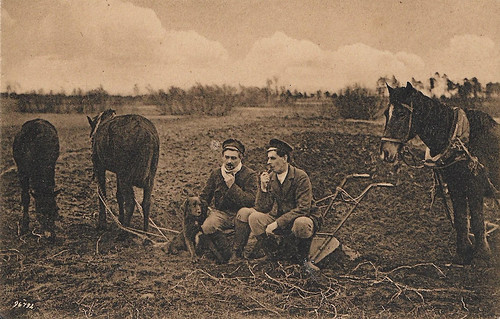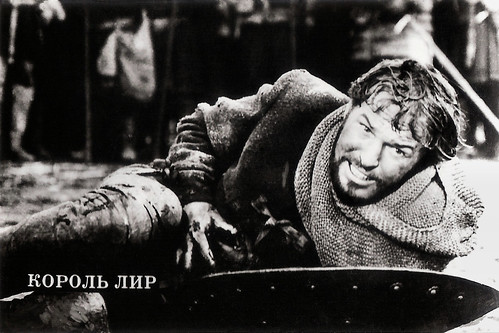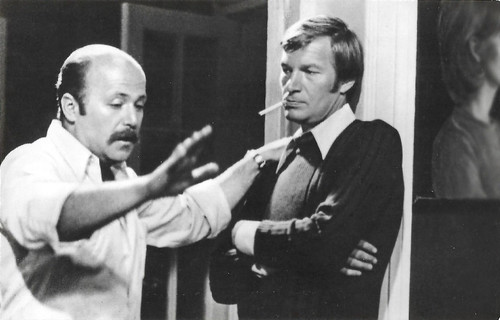Latvia

Latvian postcard by J.A.Kukurs, Riga, no. 96792. Photo: publicity still for Es karā aiziedams/As I Go Off to War (Vilis Segliņš, 1920).
Es karā aiziedams/As I Go Off to War (Vilis Segliņš, 1920) was the first national drama film of the cinema of Latvia. It premiered on 9 November 1920, which was the reason for Latvia to celebrate its first 100 years of national cinema in 2020. The film is a family drama set against the backdrop of the First World War and Latvia's freedom struggle. Director Vilis Segliņš was also the scriptwriter. The actors were Alfrēds Amtmanis-Briedītis, Ludmila Špīlberga, M. Komisārs, Aleksis Mierlauks, Berta Rūmniece, Jānis Ģērmanis, Paula Baltābola, Teodors Valdšmits, and Lilija Ērika. NB IMDb doesn't know the film, which is now considered lost.

Latvian postcard. Lilija Štengele and Karlis Pabriks in the stage play 'Mana māsa un es' (My Sister and I). D.T. probably stands for the Dailes Theatre of Riga, the main repertory theatre of Latvia.
Kārlis Pabriks (1898-1977) was a Latvian actor and director who worked for many years at the Dailes Theatre. As far as known he acted in only one film, Dzimtene sauc (Aleksandrs Rusteiķis, 1935), a film IMDb does not mention. The film, based on a script by V. Lāčs and the first Latvian sound film, depicts, with a certain patriotic tone, a traditional-style wedding party of Dravnieku Velta (Milda Zīlava) and Varkaļu Jānis (Pabriks). The film doesn't have a lot of plot and the lighting was poor, but it has interesting documentation of local rites on courting and wedding.

Latvian postcard. Peteris Lucis and Nina Melbarde in Zvejnieka dels/The Fisherman's Son (Villis Lapenieks, 1940).
Vilis Lapenieks’ film Zvejnieka dels/The Fisherman's Son was a national blockbuster and created such excitement that at its premiere on 2 January 1940, the public at the Splendid Palace broke down the theatre’s doors. Deemed a “relic of bourgeois Latvia”, it was hidden during the Soviet years. When independence was regained, the film was once again up on the screen and became a symbol of the youth of free Latvia.

Latvian postcard by IRA, Riga, no. 306. Milda Zilava in Zvejnieka dels/ The Fisherman's Son (Villis Lapenieks, 1940).
In Zvejnieka dels/The Fisherman's Son (1940), Oskars (Peteris Lucis) lives in a typical seaside village, but wants to break free of his father’s rule and the old ways – he dreams of new, large nets, an ice-cellar, and the fishermen’s independence from the fish wholesaler. At first, no one wants to believe in Oskars’ plans, except for happy-go-lucky Fredis. With the help of Fredis, Oskars builds a new fish trap, gaining admiration from even the old fishermen. Love and deceit also play into the story, as do colorful village characters and folksy songs, which have since been absorbed into national folklore. Milda Zīlava played Zenta.

Russian postcard by Izdanie Bjuro Propagandy Sovetskogo Kinoiskusstva, Moscow, no. A14212, 1967. Photo: G. Ter-Obanecova. Dzidra Ritenberga.
Latvian actress and director Dzidra Ritenberga (1928-2003) made her film debut as an actress in 1956. She became known to an international audience a year later for the title role in Vladimir Braun's Latvian-language feature film Malva (1957) in which she appeared alongside Anatoly Ignatiev and Pavel Ussovnichenko. She played the attractive and restless wife of a provincial fisherman who turns the heads of all the men in the village and embarks on a love triangle. At the 1957 Venice Film Festival, Ritenberga was awarded the Coppa Volpi for Best Actress of the Film Festival for her role. Ritenberga became a regular film actress in Soviet cinema, in both Latvian and Russian-language productions. However, she was unable to repeat her early international success. In 1973, Ritenberga trained as a director at the Latvian Conservatory in Riga. From the mid-1970s, she directed several feature films. Her last work was Valsis mūža garumā/Waltzing Through Live (1991), which was shown at the 1991 Soviet Women and Cinema film festival in Moscow.

Latvian (former Soviet Union) postcard, Riga, 1982. Photo: Lenfilm. Vija Artmane and Evgeniy Matveev in Rodnaya krov/Blood Ties (Mikhail Yershov, 1964).
Alida 'Vija' Artmane (1929-2008) was a popular Latvian stage and screen actress, who had her film breakthrough with Rodnaya krov/Blood Ties (1964) and was henceforth called "Mother Latvia". Rodnaya krov/Blood Ties deals with a soldier on leave (Matveev) who stops to help a woman (Artmane) run a ferry and bring up her three children while her husband is away at war.

Russian postcard by Bjuro Propagandy Sovetskogo Kinoiskusstva, Moscow, no. A-319, 1979. Photo: I. Gievasheva. Gunārs Cilinskis
Latvian actor Gunārs Cilinskis (1931-1992) had a rich career in mainly Russian and Latvian cinema, both as actor and director. His film debut took place in 1958, at Riga Film Studio, where he starred opposite Vija Artmane in Chuzhaya v posyolke/Stranger in the Village (Ada Neretniece, 1959). Memorable are also Mērnieku laiki/The Times of the Surveyors (Voldemārs Pūce, 1968), Nāves ēnā (Rūdolfs Blaumanis, 1971), the Russian-Hungarian Derzhis za oblaka/Hold on to the Cloud (Péter Szász, Boris Grigoriev, 1971), Ceplis (Rolands Kalniņš, 1972), and Teātris (Jānis Streičs, 1978) starring Vija Artmane. In all of these films, Cilinskis had the male lead or was the male antagonist. From 1976 he also was a film director at the Riga Film Studio, debuting with Ezera Sonate/Lake Sonata (1977) with Vari Brasla.
Lithuania

German postcard by Ross Verlag, no. 3440/1, 1928-1929. Photo: Alex Binder, Berlin. Elisabeth Pinajeff.
Elisabeth Pinajeff (1900-1995) was a Russian-Lithuanian actress who starred in German and French cinema in the 1920s and 1930s. In the 1950s she was also involved in the notorious scandal of the Ballets roses. She supposedly played in two silent Russian films, but it is unknown which films. At age 19, she married an engineer. When her husband got a job in Germany, she moved there with him.

Spanish postcard by Marte. Sent by mail in 1957. Photo: Jacques Sernas in Helen of Troy (Robert Wise, 1956).
Lithuanian-born French actor Jacques (sometimes: Jack) Sernas (1925-2015) had an international film career of more than sixty years. Sernas was the son of the Baltic minister of justice, Jokūbas Šernas, a signatory of the Act of Independence of Lithuania in 1918. He died six years later when Jacques was a year old. His Russian mother took him to Paris where he received his formal education. The handsome blonde appeared as the hero of Peplum spectacles and adventure films and later, he worked as a character actor. Sernas is perhaps best-known as Paris in the Hollywood epic Helen of Troy (Robert Wise, 1956).

Soviet postcard by Izdanie Bjuro Propagandy Sovetskogo Kinoiskusstva, no. 3, 107/72, 1972. Photo: Arkadi Zager. Donatas Banionis at right as Don Francisco de Goya y Lucientes and Mikhail Kozakov as Ambassador in Goya – oder der arge Weg der Erkenntnis/Goya or the Hard Way to Enlightenment (Konrad Wolf, 1971). The postcard was issued in 150,000 copies. Retail price: 8 Kop.
Lithuanian and Soviet actor Donatas Banionis (1924-2014) is best known in the West for his performance in the lead role of Andrei Tarkovsky's classic Science Fiction film Solaris (1972) as Kris Kelvin. In 1959, Banionis started to act in films. He made his film debut in the Lithuanian film Adomas nori buti zmogumi/Adam Wants To Be A Human (Vytautas Zalakevicius, 1959). His performance of the farmer Vaitkus in Niekas nenorėjo mirti/Nobody Wanted to Die (Vytautas Žalakevičius, 1965) won him the award for best actor at the Karlovy Vary film festival. Soon he was a highly requested actor, with many parts in prestigious national and international productions.

Soviet collectors card. Photo: Regimantas Adomaitis in Korol Lir/King Lear (Grigori Kozintsev, Iosif Shapiro, 1971).
Lithuanian film and stage actor Regimantas Adomaitis (1937) made his film debut in Vienos dienos kronika/The Chronicle of one Day (Vytautas Zalakevicius, 1963) with Donatas Banionis. In 1966 he had his breakthrough with Niekas nenorėjo mirti/Nobody Wanted to Die (Vytautas Žalakevičius,1966). This action drama is set in a small Lithuanian farming community after the Second World War. The village is divided as the communists battle those in favor of national independence. When the leader of the community is killed, the man's four sons, including Adomaitis, set out to avenge his death. Adomaitis, director Žalakevičius, and cinematographer Jonas Gricius were awarded the USSR State Prize for the film in 1967. That year, he also acted in the a-typical Soviet war film Vostochny koridor/Eastern Corridor (Valentin Vinogradov, 1966). He appeared as Edmund in the Shakespeare adaptation Korol Lir/King Lear (Grigori Kozintsev, Iosif Shapiro, 1971), for which Dmitri Shostakovich composed the score. Years later, he co-starred with Donatas Banionis in the Soviet Lithuanian-language war film Gruppa krovi nol/Faktas/Facts (Almantas Grikevicius, 1981). In 1988 he with other 34 prominent people created Sąjūdis Reform Movement, which eventually led to the declaration of independence of Lithuania on 11 March 1990. His most recent film is the Norwegian drama Iskyss/The Ice Kiss (Knut Erik Jensen, 2008).

Russian postcard by Bjuro Propagandy Sovetskogo Kinoiskusstva, Moscow, no. A319, 1980. Photo: G. Ter-Ovanekova. Algimantas Masiulis.
Lithuanian film and theatre actor Algimantas Masiulis (1931-2008) made his film debut in 1957 in the episodic role of an officer in the film Ignotas grįžo namo (Aleksandr Razoumny, 1957). In 1966, Masiulis became a real celebrity after the release of the film Niekas nenorėjo mirti/Nobody Wanted to Die) (Vytautas Žalakevičius, 1966). He also acted as Squire Relawney opposite Boris Andreyev as Long John Silver in Ostrov sokrovishch/Treasure Island (Yevgeni Fridman, 1972), and as Prince John in Ballada o doblestnom rytsare Ayvengo/Ivanhoe (Sergey Tarasov, 1983). Masiulis' career included about 160 stage roles and about 100 screen parts.

Russian postcard by Bjuro Propagandy Sovetskogo Kinoiskusstva, Riga, 1977. Juozas Budraitis and Aleksandr Kalyagin in Podranki/Wounded Game (Nikolai Gubenko, 1977).
Soviet and Lithuanian theatre and film actor Juozas Budraitis (1940) became a People's Artist of the Lithuanian Soviet Socialist Republic in 1982. His film career began in 1961 when he played in an episode of the film Kai susilieja upes/When the Rivers Merge (Balys Bratkauskas, Boris Schreiber, 1961). As a third-year student at the university, the director Vitautas Prano Jalakiavitchous invited him to play the role of Jonas in the famous Lithuanian film Niekas nenorėjo mirti/Nobody Wanted to Die (Vytautas Žalakevičius, 1965), which Donatas Banionis starred in. This film marked the beginning of Juozas' fame, and he acted in many international films, including Sluzhili dva tovarishcha/Two Comrades Were Serving (Yevgeni Karelov, 1968), Korol Lir/King Lear (Grigoriy Kozintsev, Iosif Shapiro, 1970), Blokada: Luzhskiy rubezh, Pulkovskiy meredian/Blockade (Mikhail Yershov, 1974), and Podranki/Wounded Game (Nikolai Gubenko, 1977), which was entered into the 1977 Cannes Film Festival.
Estonia

German postcard. Photo: Juhan Nõmmik and Elly Põder-Roht in Noored kotkad/The Young Eagles (Theodor Luts, 1927), released in Germany as Drei junge Adler (Three Young Eagles). Juhan Nõmmik as the blacksmith Laansoo, defending his sister Hilja (Elly Põder-Roht).
Noored kotkad/The Young Eagles is situated shortly after the end of World War I: the young republic Estonia has proclaimed its independence from Soviet Russia. Now it is put to the test and must assert its independence militarily in the Estonian War of Independence (1918-1920) against the old rulers. This rare Estonian silent war film was shot for the production company Siirius Film in the summer of 1927 in Tartu. The film was directed by Theodor Luts, one of the most renowned Estonian directors of the interwar period. He had himself fought in the Estonian War of Independence, including the battles of Paju and Cēsis. The film studio stood in the courtyard of Luts' house at Aia tänav 19, while location shooting was done in Tartumaa, near Mustvee, in Värska, and in Petserimaa. The original length of the film was about one hundred minutes. Noored kotkad was Luts' first feature film - and after the tragicomedy Kevade unelm by Voldemar Päts, the first real feature film from Estonia ever. Noored kotkad was very positively received among the Estonian population. The film was also exported abroad and was shown in Paris as Les Aiglons, in Warsaw, and probably in Berlin as Drei junge Adler, in 1928. In 2008, Noored kotkad was restored and digitised with a total length of 87 minutes.

Russian postcard. Photo: Mosfilm. Lembit Ulfsak in Legenda o Tile/The Legend of Till Ullenspiegel (Aleksandr Alov, Vladimir Naumov, 1977), an adaptation of the classic Belgian novel by Charles de Coster.
Estonian actor Lembit Ulfsak (1947-2017) had a rich career in Soviet and Russian cinema and TV. From 1969 he acted in film while from 1985 to 1994 he was an actor in Tallinnfilm Studios. In 1976, Lembit Ulfsak had a major breakthrough as the mischievous Till Ulenspiegel in the film Legenda o Tile/The Legend of Till Ullenspiegel (1977). He was also known for the Estonian films Keskea rõõmud/The joys of Keskea (Lembit Ulfsak, 1987), Doktor Stockmann/An Enemy of the People (Mikk Mikiver, 1989), and Mandariinid/Tangerines (Zaza Urushadze, 2013), which was nominated for the Oscar for Best Foreign Film.
Cinema Splendid Palace and Film Museum of Riga

Splendid Palace, Elizabetes iela 61, Riga, LV-1050, Latvia.
With its neo-baroque facade and neo-Rococo style interior, Cinema Splendid Palace in Riga is a national architectural monument. Splendid Palace is a place where you can see Latvian film premieres, national and international film festivals, performances, concerts, and enjoy opera and ballet live transmissions from the world-famous opera houses and festivals. Splendid Palace has two screening halls with 749 seats altogether. The founders of Splendid Palace were Vasilijs Jemeljanovs and Leonids Falsteins. It was the first free-standing building in Riga intended exclusively for film screening with a hall for 824 viewers. The building was designed by architect Fridrihs Karlis Skujins (1880–1957). The grand opening of the cinema took place on 30 December 1923 with the American film Under Two Flags (Tod Browning, 1922). Since the 1930s Splendid Palace has been the main venue of Latvian film premieres.

Kino Muzejs, Peitavas iela 10, Rīga LV 1050, Latvia.
We were charmed by this little film museum when we visited Riga in 2019. A hidden gem.

Soviet postcard by Izdatelʹstvo 'Planeta' Fabrika Fotopečati, Moscow, no. 32, 1978. This postcard was printed in an edition of 25.000 cards. The price was 8 kop. Captions: S. M. Eisenstein in Riga, 1910. Drawing of a queue, 1916.
Famous Soviet film director and film theorist Sergei Mikhailovich Eisenstein (1898-1948) was born in Riga, Latvia (then part of the Russian Empire in the Governorate of Livonia). He was the son of the famous architect Mikhail Osipovich Eisenstein. Sergei became a pioneer in the theory and practice of montage. He is noted in particular for his silent films Stachka/Strike (1925), Bronenosets Potyomkin/Battleship Potemkin (1925), and Oktyabr': Desyat' dney kotorye potryasli mir/October: Ten Days That Shook the World (1928), as well as the historical epics Alexander Nevsky (1938) and Ivan Grozniy/Ivan the Terrible (1944, 1958).
Sources: Inga Perkone (100 years of Latvian cinema), Michael Kaminsky (IMDb), Time Note (Latvian), Wikipedia, and IMDb.
No comments:
Post a Comment